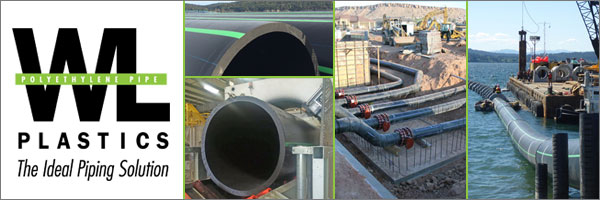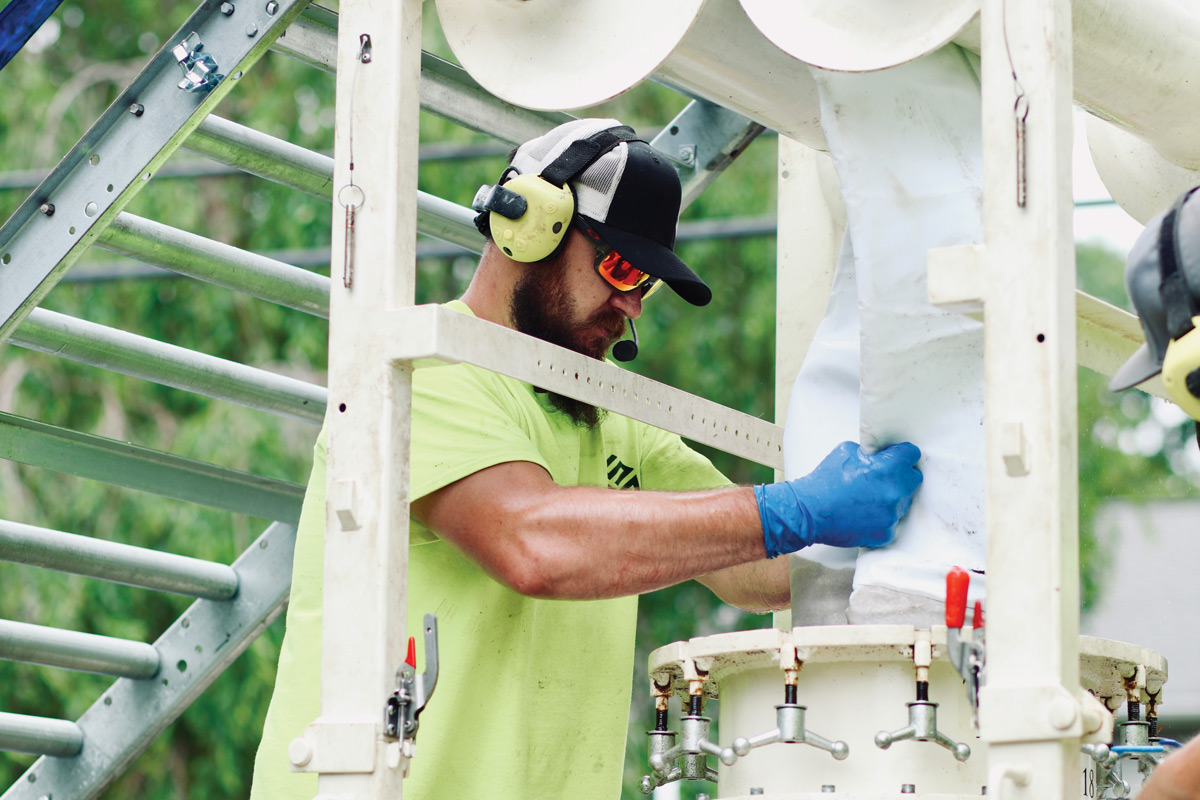
Large Diameter HDPE Solves Deep Combined Sewer Overflow in King County, Washington
In 2016, to meet EPA stormwater control guidelines and reduce the strain on its local treatment plant during major rain storm events, King County, Washington installed a new pipe.
The new gravity flow pipeline would convey water into a 1.5 million-gallon tank that would hold excess water until the plant could process it. Soon after, however, it was noticed that no water was flowing into the tank, and it was determined that the new pipeline was clogged somewhere along the 3,200-ft run. A break in the pipeline at a joint was later found that allowed soil into the line, causing the blockage.
To fix the problem, 34-in. IPS DR9 PE 4710 high-density polyethylene (HDPE) pipe was installed using pipe bursting, which broke the FPVC pipe as the new HDPE (PC 250) pipe from WL Plastics (Ft. Worth, Texas) was pulled in behind the bursting head. The original pipeline was 32-in., DR14 (PC 305) FPVC installed using horizontal directional drilling (HDD) at depths of more than 150 ft.
When the project was designed, HPDE pipe was given as an option on the bid documents, but another pipe type was selected due to its advertised strength, assumed cost savings and assumed flow capacity. “But what they didn’t realize is that HDPE pipe’s better ductility, higher flexibility and higher yield tensile strain capacity – up to 9.9 percent (per EPRI) – are more essential than brute strength and assumed savings especially in trenchless installations,” explained Camille George Rubeiz, P.E., F. ASCE, senior director of engineering, Municipal and Industrial Division of the Plastics Pipe Institute Inc. (PPI).”
PPI is the major North American trade association representing all segments of the plastic pipe industry. WL Plastics is a member company of PPI.
The design-build project was to control the combined sewer overflow and meet federal regulations. Municipalities are required to maintain a clean water system through the Clean Water Act and to keep their National Pollutant Discharge Elimination System (NPDES) permit for treating stormwater.
The EPA’s Combined Sewer Overflow (CSO) control policy is a national framework for controlling CSOs through the NPDES permitting program. It provides guidance on how communities with CSOs can achieve Clean Water Act goals in a flexible, cost-effective manner.
When it rains, storm sewers can overflow into the sanitary portion of the combined sewer, sometimes overwhelming the capacity of the treatment plant. A water quality storage system will hold back the storm water to alleviate the flooding in the storm sewers so the effluent can be stored and treated later. Until the new pipeline was added, the county’s system had one pipeline for stormwater and sewage. During large rain storms, the pipeline would backup and discharge sewage into Puget Sound.

The HDPE has a wall thickness of 3.75 in., which, along with the PE 4710 resin, provided the extra tensile strength for pipe bursting and for the deep burial loads to feed the new HDPE pipe into the fractured PVC pipe. The ends of each 50-ft section of HDPE pipe were heat fused together to create a monolithic pipeline system per well-established ASTM standards.
“According to a recent Utah State University report, HDPE pipe is the No. 1 material for trenchless construction,” stated Rubeiz. “It has high flexibility, a tight bending radius, high impact resistance (10 to 12 ft-Ibf/in per AWWA M55), high ductility, high strain capacity and well-established ASTM fusion and HDD standards. These attributes, plus having the longest fatigue life, add up to make it the best seismic solution and an excellent material for Washington State and for the major trenchless installations such as HDD, sliplining, Swagelining and pipe bursting. Long continuous segments of HDPE pipe are butt-fused together per ASTM standards (F2620, F3190) and/or electro-fused per ASTM F1055/F1290 and MAB-1/MAB-2. Additionally, according to the PPipe I Pipeline Analysis & Calculation Environment — PPI PACE — design tool, HDPE provides the largest pipe ID and largest DR for water hammer and fatigue conditions.”
RELATED: Fort Wayne Chooses HDPE and HDD for Water Main Replacement Program
Rebutting a common marketing message from competitive material manufacturers, Rubeiz stated, “Matching the ID of other pipe materials to the ID of HDPE for flow and PC will yield incorrect results.
“To date, we do not know of any official, documented explanation for the cause of the problem, nor will we comment or speculate on the cause,” he said. “What we do know is that the repair was made and that the system is now active, and that we are happy for the residents of Magnolia.”
Steve Cooper is president of SCA Communications.
Editor’s Note: From Richard Nichols, P.E., technical director at Uni-Bell PVC Association: A recent article entitled, “Large Diameter HDPE Solves Deep Combined Sewer Overflow in King County, Washington” published on February 10 by Trenchless Technology contained a statement which misrepresents a study performed by Utah State University. In the article, a quote attributed to Camille Rubeiz stated that, “According to a recent Utah State University report, HDPE pipe is the No. 1 material for trenchless construction.” Mr. Rubeiz should clarify which specific Utah State report he is referencing. However, the report referenced is almost certainly the 2018 Utah State University report entitled, Water Main Break Rates in the USA and Canada: A Comprehensive Study. The report does not make any such statement, implied or otherwise. The only mention of HDPE pipe as it relates to usage can be found on page 41 of the report stating, “HDPE pipe at 66% allowance for use in water systems represents a high degree of acceptance for trenchless applications such as pipe bursting and directional drilling…” No rankings for pipe materials in trenchless applications are shown in the report.
Trenchless Technology reached out to Camille Rubeiz for comment and this was his response: ”The report I referred to in my quote was indeed the Utah study, Water Main Break Rates in the USA and Canada: A Comprehensive Study. It does, just as Mr. Nichols’ states, report that HDPE pipe has a 66% allowance rate, etc. This majority percentage, therefore, does make HDPE pipe the Number 1 material for trenchless construction. I stand by my statement.”





